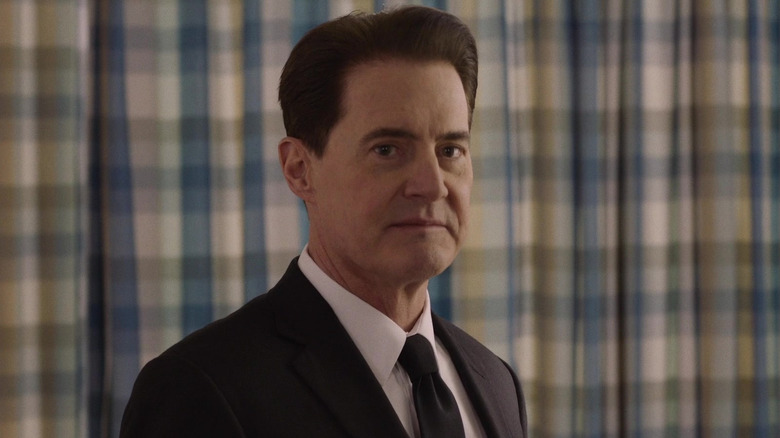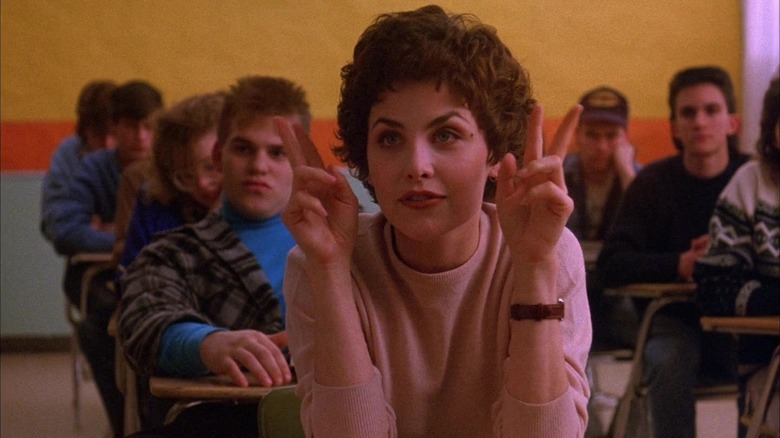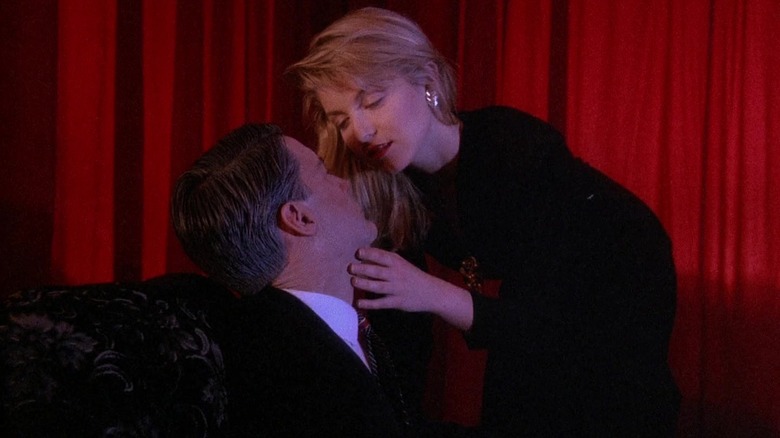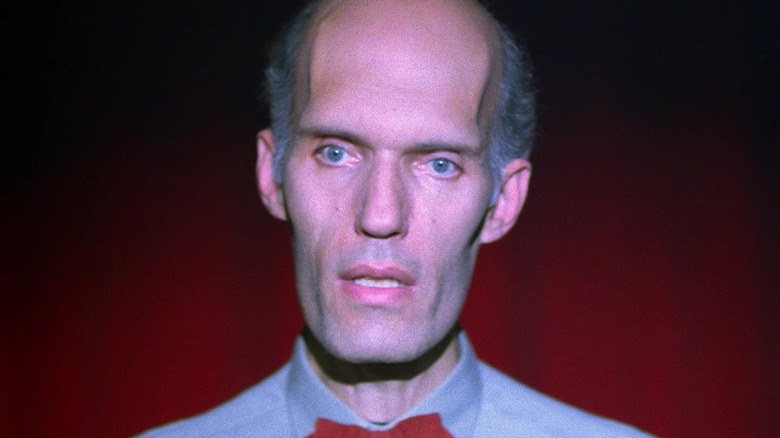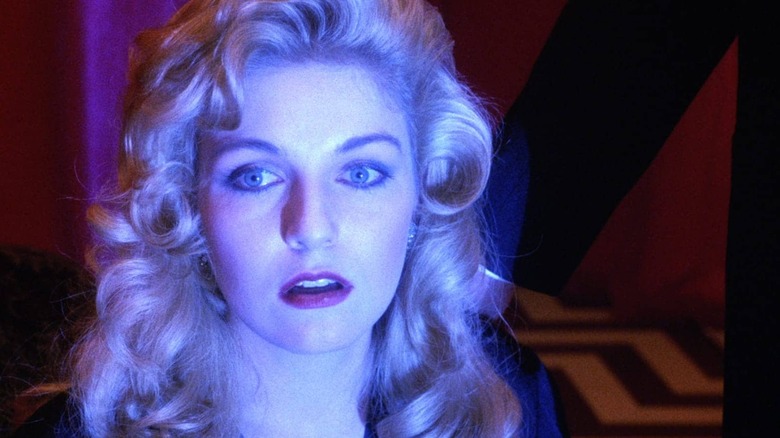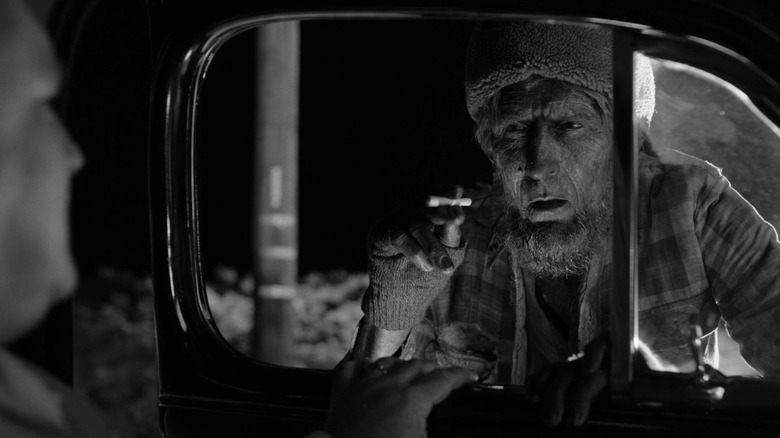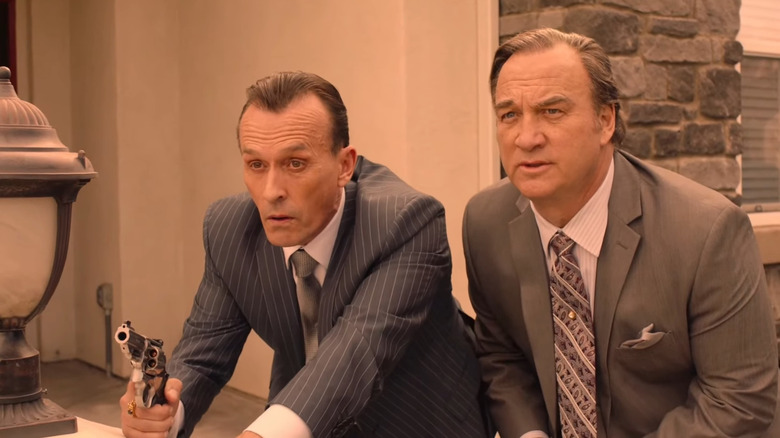5 Essential Twin Peaks Episodes Everyone Needs To Watch At Least Once
For a show that only lasted two seasons (one and a half seasons, really) during its original run, "Twin Peaks" has cast a long shadow. You can draw a clear line from this series' popularity to the later success of "The Sopranos" in the late 1990s, "Lost" in the 2000s, and "True Detective" in the 2010s. This was the show that proved there was indeed an audience for weird, experimental, serialized TV.
Obviously the best way to watch "Twin Peaks" would be in its full chronological order. That said, here is a list of five of the most important episodes of the show. These episodes are not just strong and exciting in their own right, but they should also hopefully give viewers an understanding of how the series evolved over its 25+ year history.
The production of "Twin Peaks" is pretty unique: It was canceled after its second season, received a prequel film (titled "Twin Peaks: Fire Walk With Me") that was unfairly panned in its time, and then it returned in 2017 with a groundbreaking third season (known as "Twin Peaks: The Return") that radically reshaped the show's legacy. "The Return" also forced viewers to take a second look at the prequel movie, turning the cultural consensus around in the film's favor.
Another thing to note is that the episodes in the show's original run have two titles. The episodes after the pilot were simply referred to as "Episode 1," "Episode 2," and so on. This sometimes causes confusion with new viewers because the first episode is titled "The Pilot," and the numbering starts with the second episode. Hence, "Episode 7" is actually the eighth episode, and so on.
The episodes would later be given fun titles that do a better job of teasing what they're about. For this list, we've included both the original and later-designated episode titles. For "The Return," meanwhile, the episodes are simply called "Part 1," "Part 2," and so forth.
Pilot/Northwest Passage (season 1, episode 1)
One of the longest episodes of the show, "The Pilot" introduced a massive collection of Twin Peaks residents and about a dozen storylines that would continue throughout the first season. This was a pretty unprecedented approach to a detective mystery series at the time. What's even more unique is how thoroughly the pilot establishes the tragedy of its inciting incident: The titular town is devastated by Laura Palmer's (Sheryl Lee) death, and the show doesn't shy away from their grief. This is not a case-of-the-week series, the pilot makes clear, and Laura Palmer is not some fun one-off mystery for the detectives to solve.
The other brilliant decision "The Pilot" makes is it avoids introducing its main (and best) character, FBI agent Dale Cooper (Kyle MacLachlan), until 35 minutes in. This is a decision that always surprises people on rewatch, because the moment Cooper shows up, it feels impossible to imagine the show could've ever existed without him. This structure helps to establish that this is a series about a town, not the case itself. (Granted, if you read the fan complaints back in the early '90s, it's clear that a lot of viewers still didn't get the message.)
Like most pilots, this episode was filmed separately from the rest of the first season, which means there are a lot of little elements that wound up being changed or dropped entirely. I especially hope you don't get too attached to Donna Hayward's sister Harriet (Jessica Wallenfels), because after this episode, she disappears off the face of the Earth.
The biggest difference between the pilot and the rest of the series is how normal this episode feels. It's still weird by the standards of '90s network television, but compared to where the show was going, it's definitely playing it safe. As ambitious as "The Pilot" is, it's still "Twin Peaks" at its most straightforward and accessible.
Episode 2/Zen, or the Skill to Catch a Killer (season 1, episode 3)
For its first two episodes, "Twin Peaks" was a strange yet mostly grounded TV show about a town rocked by a tragic, senseless murder. The series' third episode, "Episode 2," continues that trend until its final scene, which gives us a dream sequence so iconic that "Scooby-Doo" wound up parodying it 20 years later. In fact, whenever any TV show pokes fun directly at "Twin Peaks," like "The Simpsons" did back in season 7, it's almost always this moment that ends up being referenced.
The mysterious Red Room, which is introduced in that final scene, is so memorable that viewers rewatching the series are often shocked to discover it's not actually featured that often in the show's original run. The Red Room feels so central to the series' mythology, and so crucial to the larger legacy of "Twin Peaks," that you would think it's surely in the show more often than this. It's only "Twin Peaks: Fire Walk With Me" and "Twin Peaks: The Return" (more on them later) that return to the Red Room more regularly. Be that as it may, this was the episode that set the groundwork for all that future weirdness.
Even outside of the ending, "Episode 3" is a damn fine cup of TV. You get to see Agent Cooper at the top of his game as a detective, and the rest of the cast has settled into the versions of their characters that fans now remember and love. "Twin Peaks" quickly moved beyond the "working out the kinks" stage every show goes through in its first season, and "Episode 2" is when everyone on the series is at the top of their game.
Episode 14/Lonely Souls (season 2, episode 7)
"Episode 14" is arguably the most important episode in the whole show, as it features the reveal of Laura Palmer's killer. Although the reveal is far more satisfying if you watch all the episodes leading up to it, I will say that there are a decent enough number of clues in "The Pilot" and "Episode 2" for you to get a good handle on the mystery.
"Episode 14" isn't just the most important episode of the original run; it's also the darkest. The reveal of the series' main villain is followed up by one of the most intense and devastating sequences in the show. It seems impossible that this sequence managed to air on primetime ABC in 1990, but somehow creators David Lynch and Mark Frost pulled the feat off. Not every fan enjoyed the reveal, or the dark turn on "Twin Peaks" that came with it, but it undeniably got people talking and made a strong mark on the medium.
Making this episode extra interesting is the behind-the-scenes drama behind it. Lynch famously didn't want to reveal Laura's killer, at least not so early, but the executives at ABC forced him to do so here. This is the rare case where I actually agree with the studio execs; revealing Laura's killer may have gone against Lynch's wishes and led to the ratings tailspin in the second half of season 2, but it also paved the way for one of the greatest prequel films ever made. Speaking of...
Bonus episode: Twin Peaks: Fire Walk With Me
The benefit of "Fire Walk With Me" not being an official episode is that I can include it here without taking up one of this list's limited five spots. "Fire Walk With Me" is a devastating film following Laura Palmer's final week before her murder. Laura Palmer has always been the true heart of the property despite being dead before "The Pilot" even begins, and "Fire Walk With Me" gives her the depth and focus she's always deserved.
After two seasons on ABC, "Fire Walk With Me" marked the first time this franchise got explicit with its drugs, sex ,and violence. The result was controversial when it first released in theaters, but the edgier approach fit in nicely with the themes of the movie; the story of Laura Palmer is the story of Twin Peaks without its charming veneer. The family-friendly ABC vibes are gone here, and all that's left is the cold hard truth that the town had failed Laura. The contrast not only makes "Fire Walk With Me" more compelling, but it also enriches the original series on rewatch.
The legacy of "Fire Walk With Me" also says a lot about David Lynch's courage as a storyteller. Although the film's beloved by "Twin Peaks" fans today, it was largely dismissed at the time of its original release and nearly killed Lynch's career. But whereas Lynch was happy to disown his previous movie flop (his 1984 adaptation of "Dune"), he never did that with "Fire Walk With Me." Telling Laura Palmer's story was always worth it to Lynch, even when hardly anybody else felt the same way.
When news of a "Twin Peaks" revival broke in the 2010s, most fans openly hoped the series would be closer to the previous seasons of the show than to "Fire Walk With Me," but Lynch and Frost disagreed. Not only did they embrace the dark, surreal approach of the movie going forward, but they made the film essential to understanding "The Return," even more so than the back half of season 2. "Fire Walk With Me" is a great example of an artist sticking to their guns and ultimately being vindicated for it decades down the line.
Part 8 (The Return, episode 8)
Picking two episodes from "The Return" is tough, especially because I really wanted to include one of the Dougie episodes. Dougie's a very bizarre, lovable character who only shows up in the revival, and he's the epitome of what many fans love (and other fans hate) about the bold, decidedly anti-nostalgia "Twin Peaks" revival.
But as important as Dougie's storyline is, it pales in comparison to the arthouse masterpiece that is "Part 8." This episode features a wordless 20-minute sequence that takes viewers inside an atomic bomb explosion. It includes some of the most stunning visuals ever put to the TV screen, all while providing an explanation (kind of) for so many of the supernatural elements we see throughout the series. There's also a Nine Inch Nails concert thrown in there for some reason.
It's hard to explain exactly why "Part 8" is so crucial to the series — seriously, just watch it — but one thing's clear: "Part 8" is something that would never in a million years be allowed to air on ABC in the '90s. It's an episode that could only exist on the show's new home at Showtime, or maybe HBO, and even then it feels wild that Showtime greenlit this. We don't know why the network allowed Lynch and Frost to make an episode that went against so many of the expected rules of TV, and which challenged its viewers on a level basically unseen in this medium, but we're glad Showtime let them take that risk.
Part 16 (The Return, episode 16)
Although I described "The Return" as being anti-nostalgia, the show still held the original series in strong regard. You can see that most clearly in "Part 16," the first episode of the revival with Dale Cooper leading front and center, and one of the few episodes where the plot is properly moving at a pace you'd expect from a standard TV show. After a season of constantly challenging and subverting viewers' expectations, "Part 16" gives viewers everything they wanted. Or at least, everything they thought they wanted.
Despite recapturing the charm of the original show, if you're watching just these five episodes you may be surprised by how unfamiliar much of the cast is. Much of the revival moves away from the town of Twin Peaks itself and establishes a whole new cast of eccentric, lovable weirdos. Not every fan was on board for this, but the ones who stuck around came to love them anyway. My personal favorites are the mafia guys seen above. In the scene in that picture, Rodney (Robert Knepper, the guy next to Jim Belushi) is about to deliver the funniest line in the entire show.
"Part 16" is a bit of an anomaly in "The Return" (the series' finale would once again refuse to settle for comfortable, familiar territory as it brought the greater "Twin Peaks" narrative to an end), but for a moment here, the show offers a celebration of everything fans loved about the original series. Although the revival was strong either way, the reintroduction of Cooper here brings in a major burst of energy as the show jumps into its final act, and it makes for a thrilling, cathartic watch. "Twin Peaks" is a dark series, but so much of "Part 16" feels unapologetically sweet.
